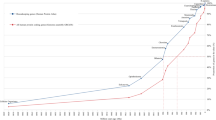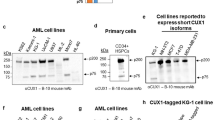Abstract
Identification and characterization of genes expressed in normal cells and decreased in their malignant counterparts is an important method for detecting candidate tumor suppressors. Using differential display of mRNAs from nontumorigenic infinite life span human fibroblast cell strain MSU-1.1 and an isogenic fibrosarcoma-derived cell line, 6A/SB1, which was derived from chemical carcinogen transformed MSU-1.1 cells, we identified a novel gene, ST7, showing sixfold lower expression in 6A/SB1 cells compared with parental MSU-1.1 cells. Molecular cloning of a near full-length cDNA revealed that the novel gene encodes a putative transmembrane protein composed of 859 amino acids: the 492 N-terminal amino acids including a fivefold cysteine-rich repeat of 40 amino acids homologous to the ligand binding repeat of the known low density lipoprotein receptor, a 24 hydrophobic amino acid stretch spanning the plasma membrane, and a C-terminal domain of 343 residues. ST7 is located on human chromosome 8, band q22.2-23.1, the same locus as the genes involved in acute myeloid leukemia and a locus of high polymorphism in cancer biopsies. The ST7 gene is widely expressed in normal human tissues and is particularly abundant in human heart and skeletal muscle. Northern analysis of 15 tumor cell lines derived from patients and 16 cell lines established from tumors formed in athymic mice by MSU-1.1 cells transformed in culture by various methods showed that 16 of the 31 cell lines have low or undetectable levels of ST7 mRNA. Furthermore, Western blotting analysis using a specific anti-peptide antibody demonstrated that the level of ST7 protein is high in normal fibroblasts and low in 12 sarcoma-derived cell lines tested. Altered expression of ST7 appears to occur at both the transcriptional and post-transcriptional levels. These studies are a first step in characterizing a novel putative receptor protein, whose expression is downregulated in some malignantly transformed cells, and which may play an important role in the transformation process of these cells.
This is a preview of subscription content, access via your institution
Access options
Subscribe to this journal
Receive 50 print issues and online access
$259.00 per year
only $5.18 per issue
Buy this article
- Purchase on Springer Link
- Instant access to full article PDF
Prices may be subject to local taxes which are calculated during checkout







Similar content being viewed by others
References
Appella E, Weber IT and Blasi F. . 1988 FEBS Lett. 231: 1–4.
Cho KR and Fearon ER. . 1995 Curr. Opin. Genet. Dev. 5: 72–78.
Daly NL, Scanlon MJ, Djordjevic JT, Kroon PA and Smith R. . 1995 Proc. Natl. Acad. Sci. USA 92: 6334–6338.
Doolittle RF, Feng DF and Johnson MS. . 1984 Nature 307: 558–560.
Farber E. . 1984 Cancer Res. 44: 4217–4223.
Fearon ER. . 1996 Biochim. Biophys. Acta. 1288: 17–23.
Fearon ER and Vogelstein B. . 1990 Cell 61: 759–767.
Feinberg AP and Vogelstein B. . 1983 Anal. Biochem. 132: 6–13.
Furuya T, Ochi H and Watanabe S. . 1989 Cancer Genet. Cytogenet. 43: 131–138.
Klein G and Klein E. . 1985 Nature 315: 190–195.
Kozak M. . 1991 J. Biol. Chem. 266: 19867–19870.
Kyte J and Doolittle RF. . 1982 J. Mol. Biol. 157: 105–132.
Liang P, Averboukh L and Pardee AB. . 1993 Nucleic Acids Res. 21: 3269–3275.
Liang P and Pardee AB. . 1992 Science 257: 967–971.
McCormick JJ and Maher VM. . 1994 Risk Anal. 14: 257–263.
Miyazaki S, Imatani A, Ballard L, Marchette A, Buttita F, Albertsen H, Nevanlinna HA, Gallahan D and Callahan R. . 1997 Genomics 46: 155–158.
Morgan TL, Yang D, Fry DG, Hurlin PJ, Kohler SK, Maher VM and McCormick JJ. . 1991 Exp. Cell Res. 197: 125–136.
Park NH, Gujuluva CN, Baek JH, Cherrick HM, Shin KH and Min BM. . 1995 Oncogene 10: 2145–2153.
Peto R. . 1977 In: Origins of Human Cancer. Hiatt HH, Watson JD, Winsten JA (eds). Cold Spring Harbor Laboratory Cold Spring Harbor: NY pp. 1403–1428.
Qing J, Maher MM, Tran H, Argraves WS, Dunstan RW and McCormick JJ. . 1997 Oncogene 15: 2159–1268.
Rabbits TH. . 1994 Nature 372: 143–149.
Reinhold DS, Walicka M, Elkassaby M, Milam LD, Kohler SK, Dunstans RW and McCormick JJ. . 1996 Int. J. Radiat. Biol. 69: 707–715.
Reznikoff CA, Kav C, Messing EM, Newton M and Swaminathan S. . 1993 Semin. Cancer Biol. 4: 143–152.
Rhim JS, Webber MM, Bello D, Lee MS, Arnstein P, Chen LS and Jay G. . 1994 Proc. Natl. Acad. Sci. USA 92: 11874–11878.
Sabatini DD, Kriebich G, Morimoto T and Adesnik M. . 1982 J. Cell. Biol. 92: 1–21.
Sambrook J, Fritsch EF and Maniatis T. . 1989 Molecular Cloning: A Laboratory Manual. Cold Spring Harbor Laboratory Press, Cold Spring Harbor, New York.
Shabtai F, Sternberg A, Klar D, Halbrecht I and Reiss R. . 1988 Cancer Genet. Cytogenet. 31: 113–118.
Stanley KK, Kocher H-P, Luzio JP, Jackson P and Tschopp J. . 1985 EMBO J. 4: 375–382.
Stone DM, Hynes M, Armanini M, Swanson TA, Gu Q, Johnson RL, Csott MP, Pennica D, Goddard A, Phillips D, Noll M, Hooper JE, de Sauvage F and Rosenthal A. . 1996 Nature 384: 129–134.
Stoner GD, Kaighn ME, Reddel RR, Resau JH, Bowman D, Naito Z, Matsukura N, You M, Galati AJ and Harris CC. . 1991 Cancer Res. 51: 365–371.
Südhof TC, Goldstein JL, Brown MS and Russell DW. . 1985 Science 228: 815–822.
Wahle E and Keller W. . 1992 Ann. Rev. Biochem. 61: 419–440.
Yang D, Louden C, Reinhold DS, Kohler SK, Maher VM and McCormick JJ. . 1992 Proc. Natl. Acad. Sci. USA 89: 2237–2241.
Acknowledgements
We thank Dr Legerski at the University of Texas, MD Anderson Cancer Center, Houston and Dr Ki-Han Kim at Purdue University, West Lafayette for kindly providing us the cDNA libraries. The expert assistance on computer work from Dr David Dewitt at Michigan State University is gratefully acknowledged. This research was supported by DHHS grants CA60907 from the National Cancer Institute and AG11026 from the National Institute on Aging.
Author information
Authors and Affiliations
Rights and permissions
About this article
Cite this article
Qing, J., Wei, D., Maher, V. et al. Cloning and characterization of a novel gene encoding a putative transmembrane protein with altered expression in some human transformed and tumor-derived cell lines. Oncogene 18, 335–342 (1999). https://doi.org/10.1038/sj.onc.1202290
Received:
Revised:
Accepted:
Published:
Issue Date:
DOI: https://doi.org/10.1038/sj.onc.1202290
Keywords
This article is cited by
-
PCB exposure and potential future cancer incidence in Slovak children: an assessment from molecular finger printing by Ingenuity Pathway Analysis (IPA®) derived from experimental and epidemiological investigations
Environmental Science and Pollution Research (2018)
-
Overexpression of LRP12, a gene contained within an 8q22 amplicon identified by high-resolution array CGH analysis of oral squamous cell carcinomas
Oncogene (2004)



